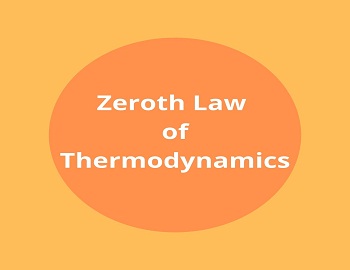Zeroth Law of Thermodynamics:
The law states that if two bodies A and B are in thermal equilibrium and A and C are also in thermal equilibrium, then B and C are also in thermal equilibrium. It may appear obvious but it is not so. For example, if B is a friend of A and C is also a friend of A, it is not necessary that B and C are also friends. The Laws of Thermodynamics are a matter of observation and experience. They are the essence of our observation of nature. Their proof lies in the fact that so far no exception to these laws has been observed.
The Zeroth Law introduces the concept of temperature to measure the degree of hotness of a body. All bodies in thermal equilibrium with each other are assigned equal temperature i.e. they have a common property called temperature which is the same for all bodies in thermal equilibrium. Thus, the temperature is that property of a body by which we know whether the body is in thermal equilibrium with another given body or not. A body not in thermal equilibrium with a given body must be either at a higher or at a lower temperature than this body. If the other body loses energy to the given body, then the other body must be at a temperature higher than the given body. If the other body gains heat energy when placed in contact with the given body, then the other body must be at a temperature lower than the given body. Thus, the temperature decides the direction of the flow of heat energy when bodies are kept in contact with each other. Heat flows from the body at a higher temperature to the body at a lower temperature. When two bodies in contact do not gain from, nor lose energy to each other, they are in thermal equilibrium or at the same temperature.
From the microscopic point of view, the thermal equilibrium is a dynamic equilibrium. For the two systems in contact, the molecules of one system are constantly colliding with the molecules of the other and losing energy to each other (the faster one loses energy while the slower one gains). But the average kinetic energy of individual molecules of one system remains equal to the average kinetic energy of individual molecules of the other system. When considering the thermodynamics of the process, we need not go to such details of individual molecules. We can discuss the behaviour of the system just in terms of macroscopic parameters (T, p, V) with the thermodynamic laws without going into these details anymore.









Comments (No)